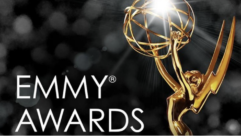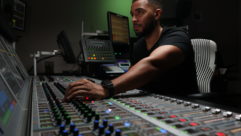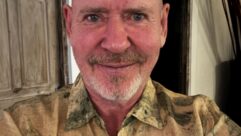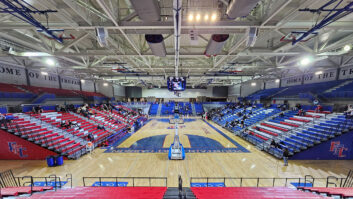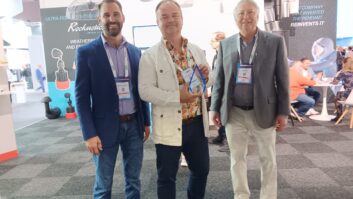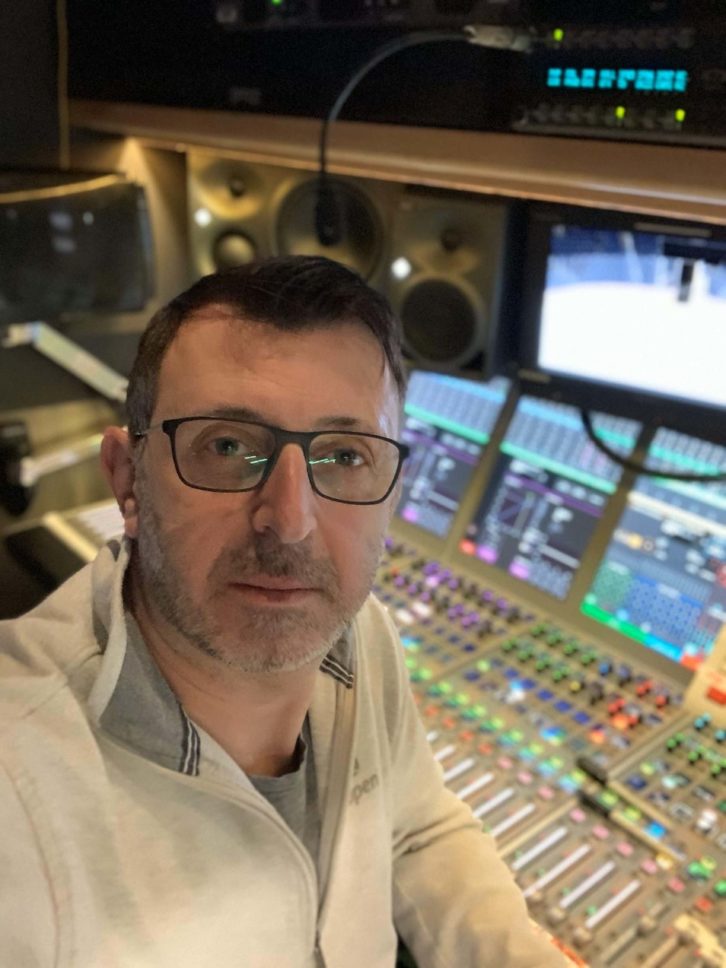
- How did you get into professional audio and what led you into this field?
In high school I was going to be an auto mechanic. All my life I loved assembling things, and I loved cars. In high school I helped a friend restore his ‘64 Stingray and helped another friend restore his old Hemi-powered ‘64 Dodge Polara and his ‘69 Mach 1 Mustang. In 1988, as I was about to graduate high school, I was involved in a life-changing car crash where I was hit head-on by another car. I was not able to work for a while, so I decided to go back to school. That’s where I met a new friend who invited me to volunteer at a local cable station working on junior hockey games for community cable. Ah the allure of junior hockey on Friday nights with pizza and beer post game! How could I resist?
I started doing handheld camera work, but I wasn’t very good because of my car crash injuries. The camera was heavy and painful for me to have on my shoulder for so long. Being a lover of rock and roll music, an acquaintance suggested I try audio because it’s an “in-the-truck job” with much less physical exertion. I volunteered at Trillium Cable in Pickering and Scarborough Ontario, Canada, from 1990 until 1994/1995 and I really enjoyed it and quickly became hooked on live sports TV. During that time, I tried to get a few jobs with TV stations without really understanding how the business worked outside of community cable. In 1992, I started college on a TV Broadcasting Course at Loyalist College in Belleville Ontario. With a college degree in-hand I was able to go out and look for an apprenticeship pretty much anywhere. This took me back to Toronto and Dome Productions.
I did a one-month internship there in the spring of 1994, working on Blue Jays Baseball, and started working games right after as an Audio Assistant. It was the time of my life; I was getting paid to watch the Blue Jays — a team that had just won back-to-back World Series. Well then August 11throlled around and MLB went on strike. I thought no big deal, right? Hockey season was just around the corner.
- We know you have a lot of experience working as both a “comms” engineer as well as a sound mixer. Which role do you prefer and why?
This has never been an easy question to answer. I love mixing and I love the Audio Guarantee role for its engineering aspect, but I think I enjoy my role as a comms engineer a little more. One reason is that I have kind of become one of the go-to guys when it comes to comms, especially in Canada. At the start, I worked really hard to understand intercom and the equipment and how to use it effectively. I was fortunate to have been taught by some of the pioneers and the best in the comms business. Though I truly didn’t excel until I broke into the US market where I was really immersed in comms. It started when an engineer friend of mine, Derrick Whittington, recommended me to Steve Raymond at ESPN to be a part of the comms team for the Winter X Games. Steve gave my name to Henry Rousseau (Associate Director ESPN Remote Production Operations)and things quickly developed for me. Henry put me to work with Jessie Heimlich, aka Mr. Intercom and I learned so much from him. This opened many doors for me and I have since worked the X Games, National College Championships, Olympics, and the Super Bowl. Comms challenges you every second of the day. I love the pressure and the challenges of giving production and all its people exactly what they want. You have to be reliable, and failure isn’t an option. I would imagine Calrec’s philosophy is similar.
- We understand that much of your background and recent work is in live sports. Can you talk us through your current role?
In normal working times, I spend most winters mixing NHL hockey; I am one of those rare breeds where I don’t travel with one team. One day I could be in Winnipeg Manitoba mixing the Jets game on Fox for the Arizona Coyotes’ feed and the next day I could be in Calgary mixing the home feed SNET show for the Calgary Flames vs. the Vegas Golden Knights. I love the variety of my work. If you look at my schedule from January to April, I will typically go from mixing the “B” pool for the World Junior Hockey Championships to doing comms for the National Football Championships on ESPN, then to NHL Hockey on TSN or SNET or even Hockey Night in Canada to comms on the Super Bowl show for NFL Network. Then it’s back to the NHL until the end of March and from there I’ll go to Georgia to work on the Masters as an AG for TBS (Tokyo Broadcast System) with the Japanese broadcaster. This variety has allowed me to meet and interact with so many talented people with whom I talk shop and philosophies on mixing and comms with some of the best in the world.
- What was it about audio broadcast that attracted you and what keeps you interested?
As I’ve said, I like the variety and the people. I genuinely like meeting new people and hearing their stories and sharing mine. I feel the bonds and friendships I’ve made will last a lifetime. Then there’s the travel part of the job; I love the travel. This job has taken me all over the world, from South America to Moscow to Korea and all over my beautiful home country of Canada.
- Can you describe a typical broadcast audio setup that you use?
People have different philosophies about this. I try to keep it simple and straightforward — tape machines and anything internal to the truck that make noise on the right, announcers and anything external to the truck on the left except for EFX, and the meat and potatoes live smack dab in the middle. I like to reserve about 24 faders in the middle of the console for all my FOP (field of play) mics and any VCA I create (which Calrec does so well) of groups of mics in the middle of the desk. I don’t mix hockey with three faders in the typical L (left), C (centre), R (right) configuration like some operators might do. I prefer to chase the puck around the ice surface and really isolate the sound to match what the viewer is seeing. It’s the style I was taught by Jeff Kozak, one of my greatest mentors, when it comes to mixing. He had a strong musical background and always talked about blending sounds using EQ and dynamic mixing.
- When did you first start working with Calrec products?
I started in the days of analogue and I worked on Neves, Yamaha, Soundcraft, Midas, SSL, Ward Beck, and of course Calrec. I believe the first Calrec I ever spent any time on was the S2 and it had to be the late 90s. Believe it or not, I still see that desk every now and then. The S2 was an absolute workhorse.
- What Calrec consoles have you used over the years?
I think I have worked with almost every Calrec desk since the S2; the Alpha, Sigma, Omega (with and without Bluefin), Artemis, Apollo, Summa and Brio.
- What’s a recent example of a project where you used Calrec technology?
In my last three events the week before sports shut down, I was working with an Apollo, a Sigma and an Artemis — all for NHL hockey.
- What are the workflow advantages of the Calrec console(s) that you’re using?
I remember working on my first digital Calrec, which was the Alpha. What I really enjoyed about it at first was how analogue it felt. You could buzz around on the surface and it felt like an S2 but with all the nonlinear advantages of how we have come to know digital console operation. I see a lot of Calrec Artemis consoles in the industry. I like the spacing between the faders; some desks have me stretching my fingers to get my mitts on the faders while others are too close and have my fingers tripping over each other. With every Calrec I’ve ever used, the fader spacing just feels right and that’s important when mixing live sports. I also like the use of color on the newer Calrecs not to mention the flexibility for metering. I also like the touch screens because they work very well and are big and easy to read. It’s very easy to copy and paste a setting and manipulate auto-faders parameters also adjusting delay settings and where the delay is inserted comes easy. Everything is well thought out and very comfortable to use. In live sports, everything happens fast and being able to make a change like adjusting an EQ or delay setting quickly makes a huge difference for the audio mixer. When production throws you a curveball, you can adapt and react without thinking about it.
- Can you talk us through the project you’ve most enjoyed working on and/or that really stands out in your career?
It has to be French Open Tennis at Roland Garros in Paris, France. My role with that went from being part of the audio engineering team to Comms Manager. In my first two years of working the French Open, I worked with Pat Daly (of VER) who was the engineer in charge of the operation and with Craig Lapsley, the lead in charge of programming the router. I was the guy installing the additional Calrec Hydra boxes, addressing them (using the Calrec app on my iPhone) and programming them to the needs of the A1s that were hired by Tennis Channel, ESPN and NBC. I created port lists specific to their needs and all the desk’s resources building the inserts for their peripheral gear, like the Dugan auto mixer or whatever else they had. I really enjoyed the engineering level stuff and being able to really dig into the desk and all the functionality of it. I’ve had some of my colleagues call me and say, “hey Stevie how do you do XYZ on this Artemis again?” Because of that experience I know the Artemis better than any desk I’ve used in the past 30 years. It’s given me the confidence to walk into a new truck on a set, shoot, strike and build the desk for my show, and be fully ready in just a couple of hours.
- What are the key milestones that you’ve seen in terms of technological shifts? How do you view the current talk of, and move to, AoIP? What’s the real-world impact?
As for AoIP, I guess I’ve been doing that for years with my comms work. RTS uses RVON, which is IP-based and it’s nice to see it now with Dante and hear the broadcast quality sound. I started mixing stereo shows that really were broadcast in mono. I made the transition to surround and now although I have not mixed anything in Atmos, I do feel I’m ready. Truthfully, AoIP is just another method of transport; analog, digital, MADI, Dante; it really is just taking a signal from A to B. Like I said earlier, I try to keep things simple. It’s important to stay up to date with technology because it moves quite fast and you certainly don’t want to be left behind.
- We’re seeing the increasing rise of eSports, especially now. How much does working in that world interest you and what experience do you have in that space?
Regarding eSports, in May 2017 I was sent to be the Audio Guarantee on the Mid-Season Invitational Riot Games Tournament, League of Legends in Rio de Janeiro, Brazil. I really had no idea what eSports was and I thought wow, this is interesting! I couldn’t believe the amount of people and the money that eSports generates. We had two Artemis consoles, two Brios, Cedar DNS8 Live noise suppression units plus Dugans — all the stuff most shows don’t have a budget for. Imagine blending theatre with a live audience and a TV dynamic; I think it’s fantastic. I also have an 11-year old son who keeps me in the loop. He wants me to get on the Fortnite circuit.
- How have second screens (smartphones, laptops) changed how mixes are produced?What about viewer expectation for the perfect viewing experience; how as that impacted how you do your job?
To be honest, a good audio mix will translate well to any type of viewing experience. Sometimes we’ll need to isolate certain microphones to match the viewers’ experience. Microphones need to be made available on the router and that all happens downstream. I would imagine that’s one way but not a difficult route. It would be hard to monitor it because our focus would be on the overall mix.
- How do you see audio evolving in the next five years?
I’ve been asked this question many times and being honest, I don’t anticipate a big change in the way we’ll be mixing sound five years from now. We still have to take a good combination of announcer voices, blend them with music or game sounds, and match them with the pictures we see to construct a television show. I think this applies with not just sports but also other types of content like news and variety programming. The method of transport will change but we still need a good mix.
If you’re asking me will there still be trucks with big beautiful Calrec consoles in them, I absolutely think yes. Even a remote production still needs an audio console onsite for signal distribution and routing. After all, what are audio consoles these days if not just another way to route audio signals.



